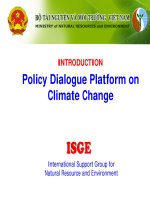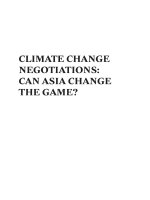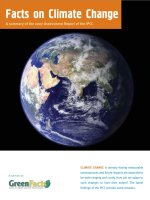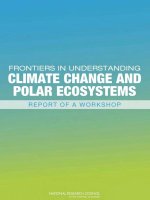CLIMATE CHANGE: AN INTEGRATED PERSPECTIVE docx
Bạn đang xem bản rút gọn của tài liệu. Xem và tải ngay bản đầy đủ của tài liệu tại đây (11.56 MB, 431 trang )
CLIMATE CHANGE: AN INTEGRATED PERSPECTIVE
ADVANCES IN GLOBAL CHANGE RESEARCH
VOLUME 1
Editor-in-Chief
Martin Beniston, Institute of Geography, University of Fribourg, Perolles,
Switzerland
Editorial Advisory Board
B. Allen-Diaz, Department ESPM-Ecosystem Sciences, University of California,
Berkeley, CA, U.S.A.
R.S. Bradley, Department of Geosciences, University of Massachusetts, Amherst, MA,
U.S.A.
W. Cramer, Department of Global Change and Natural Systems, Potsdam Institute for
Climate Impact Research, Potsdam, Germany.
H.F. Diaz, NOAA/ERL/CDC, Boulder, CO, U.S.A.
S. Erkman, Institute for Communication and Analysis of Science and Technology –
ICAST, Geneva, Switzerland.
M. Lal, Centre for Atmospheric Sciences, Indian Institute of Technology, New Delhi,
India.
M.M. Verstraete, Space Applications Institute, EC Joint Research Centre, Ispra (VA),
Italy.
CLIMATE CHANGE:
AN INTEGRATED PERSPECTIVE
Edited by
Pim Martens
International Centre for Integrative Studies (ICIS),
Maastricht University,
Maastricht, The Netherlands
and
Jan Rotmans
International Centre for Integrative Studies (ICIS),
Maastricht University,
Maastricht, The Netherlands
Co-editors:
Darco Jansen
Koos Vrieze
Open University Heerlen
University Maastricht
KLUWER ACADEMIC PUBLISHERS
NEW YORK, BOSTON, DORDRECHT, LONDON, MOSCOW
eBook ISBN: 0-306-47982-6
Print ISBN: 0-7923-5996-8
©2003 Kluwer Academic Publishers
New York, Boston, Dordrecht, London, Moscow
Print ©1999 Kluwer Academic Publishers
A
ll rights reserved
No part of this eBook may be reproduced or transmitted in any form or by any means, electronic,
mechanical, recording, or otherwise, without written consent from the Publisher
Created in the United States of America
Visit Kluwer Online at:
and Kluwer's eBookstore at:
D
ordrecht
CONTENTS
Contributors
xiii
xv
Preface
Chapter 1: Climate change: an integrated perspective
(P. Martens, J. Rotmans)
1
1
2
5
Introduction
Climate change in perspective
This book
1.1
1.2
1.3
Chapter 2: The climate system
(D. Jansen)
Introduction
Radiation budget
2.1
2.2
11
11
12
13
14
18
19
23
26
33
33
36
The greenhouse effect
Greenhouse gases
The enhanced greenhouse effect
2.2.1
2.2.2
2.2.3
2.3
Circulation of energy
Atmospheric circulation
Oceanic circulation
2.3.1
2.3.2
Changing climate
Solar radiation and Milankovich
Albedo and albedo-temperature feedback
Greenhouse gases and the water vapour-temperature
feedback
Crucial role of aerosols and clouds
2.4.1
2.4.2
2.4.3
2.4.4
38
38
41
42
45
48
49
50
Changing climate interacting with the different spheres
Cryosphere
Biosphere and biogeochemical feedbacks
Geosphere
2.5.1
2.5.2
2.5.3
Discussion
References
2.6
2.5
2.4
vi
51
Chapter 3: Modelling of the climate system
(J. Shukla, J.L. Kinter, E.K. Schneider, D.M. Straus)
Introduction
Simple climate modelling
3.1
3.2
3.2.1
3.2.2
Energy balance climate models
Radiative-convective models
3.3 General circulation models (GCMs)
51
52
52
55
56
56
58
60
61
66
68
70
72
75
79
82
83
87
90
92
95
Introduction
Basic characteristics
Climate sensitivity
Atmospheric modelling
Ocean modelling
Modelling other subsystems
Choices in the philosophy and design of GCMs
Equilibrium experiments
Transient experiments
3.3.1
3.3.2
3.3.3
3.3.4
3.3.5
3.3.6
3.3.7
3.3.8
3.3.9
Model calibration
Model validation
3.4
3.5
Comparison with observational datasets
Inter-model comparison
3.5.1
3.5.2
3.6 Climate predictions
Prediction of seasonal to inter-annual variations
Prediction of decadal variations
Prediction of changes in variability due to climate
3.6.1
3.6.2
3.6.3
change
3.7 Limitations in present climate modelling
96
97
98
3.7.1
3.7.2
The different subsystems
The complex interaction
3.8 Discussion
References
Chapter 4: Global biogeochemical cycles
(J. Rotmans, M. den Elzen)
Introduction
The global carbon cycle
4.1
4.2
4.2.1
4.2.2
4.2.3
4.2.4
Introduction
The present global carbon cycle
Anthropogenic perturbation of the global carbon cycle
Conclusions
The global nitrogen cycle
Introduction
4.3
4.3.1
105
106
106
108
110
112
112
112
105
100
101
102
vii
4.3.2
4.3.3
4.3.4
The present nitrogen cycle
Anthropogenic disturbance of the global nitrogen cycle
Conclusions
112
118
122
122
122
123
4.4
The global phosphorus cycle
4.4.1
4.4.2
4.4.3
Introduction
The present phosphorus cycle
Anthropogenic perturbation of the global phosphorus
cycle
4.4.4
Conclusions
4.5
The global sulphur cycle
4.5.1
4.5.2
4.5.3
4.5.4
Introduction
The present sulphur cycle
Anthropogenic perturbation of the global sulphur cycle
Conclusions
4.6
4.7
Interaction between the global element cycles and climate change
Discussion
References
Chapter 5: Causes of greenhouse gas emissions
(K. Chatterjee)
Introduction
Industry
5.1
5.2
5.2.1
5.2.2
5.2.3
5.2.4
5.2.5
Main developments in developed countries
Main developments in developing countries
Chemical industry
Non-chemical industrial sectors
Future projections
5.3
Energy resources
5.3.1
5.3.2
5.3.3
5.3.4
Fossil resources
Renewable energy resources
Nuclear energy resources
Minerals
5.4
Population
5.4.1
5.4.2
5.4.3
5.4.4
Historical growth
Birth rate
Death rate
Future population projections
5.5
Land use
Deforestation
Urbanisation
Burning
5.5.1
5.5.2
5.5.3
5.6
Agriculture
126
127
127
127
128
131
132
132
136
137
143
143
148
148
149
150
151
154
154
155
158
165
166
167
167
168
169
170
171
171
180
180
182
viii
Agricultural activities
International trade
5.6.1
5.6.2
5.7
Transport
Road transport
Air transport
Rail transport
Marine transport
5.7.1
5.7.2
5.7.3
5.7.4
5.8
5.9
Discussion
Conclusions
References
Chapter 6: Impacts of climate change
(M.L. Parry, P. Martens)
6.1
6.2
Introduction
Methodology of impact assessment
6.2.1
6.2.2
Approaches to the assessment of impacts
The selection of methods for impact assessment
6.3
Assessments of impacts in different systems and sectors
6.3.1
6.3.2
6.3.3
6.3.4
6.3.5
Sea-level rise, coastal zones and small islands
Impacts on food and fibre production
Impacts on water supply and use
Impacts on terrestrial and aquatic ecosystems
Human health
6.4
6.5
Adapting to climate change
Discussion
References
Chapter 7: Integrated Assessment modelling
(J. Rotmans, M. van Asselt)
7.1
7.2
7.3
Introduction
Methods for integrated assessment
IA modelling
239
7.3.1
7.3.2
7.3.3
History
Model typology
IA-cycle
239
241
244
244
244
253
255
255
257
259
259
263
7.5
Challenges
7.5.1
7.4
7.4.1
7.4.2
7.4.3
Aggregation versus disaggregation
Treatment of uncertainty
Blending qualitative and quantitative knowledge
Critical methodological issues in IA modelling
IA modelling of population and health
182
185
187
188
191
192
194
195
196
198
201
201
201
202
204
210
210
213
220
223
227
233
234
235
7.5.2
7.5.3
7.5.4
7.6
IA modelling of consumption behaviour
Multi-agent modelling
Regional IA modelling
The next generations of IA models
References
264
266
266
269
271
ix
Chapter 8: Perspectives and the subjective dimension in
modelling
(M. van Asselt, J. Rotmans)
277
8.1
8.2
8.3
8.4
8.5
8.6
277
280
283
295
303
311
313
Introduction
From subjectivity to plurality
Framework of perspectives
Methodology of multiple model routes
Application of multiple model routes
Conclusions
References
Chapter 9: Global decision making: climate change politics
(J. Gupta)
9.1
9.2
9.2.1
Introduction
From scientific description to problem definition
Scientific uncertainty and controversy
9.2.2
9.2.3
9.2.4
9.2.5
Types of science and problems
The use of science by policy makers
From scientific issue to political agenda item
An integrated science-policy model
9.3
The technocratic stage – I
319
319
320
320
321
325
328
329
332
332
334
336
337
338
339
339
344
345
346
346
9.4.1
9.4.2
9.4.3
9.5
9.4
The adhocracy stage – II
Underlying North-South conflicts: problem definition,
science, values and solutions
Underlying domestic conflicts: environment versus
growth
A stage of slow-down?
Beyond adhocracy: stage III and IV
9.5.1
9.5.2
Resolving domestic issues: the stakeholder model (III)
International issues: beyond the stakeholder
9.3.1 Regime formation: a brief history
9.3.2 Different country positions
9.3.3 The North-South angle
9.3.4 The consensus in the climate convention
9.3.5 Information sufficient for euphoric negotiation
x
approach (IV)
348
349
350
9.6
Conclusion
References
Chapter 10: Epilogue: scientific advice in the world of power
politics
357
(S. Boehmer-Christiansen)
10.1
10.2
Introduction
The role of scientific advice and the climate treaty
10.2.1
10.2.2
10.2.3
10.2.4
10.2.5
Moving towards implementation?
Early doubts: scientific uncertainty and interests
Believing scientific advice on climate change
The need for transparency
Nightmares of policy-makers
10.3
10.3.1
10.3.2
Eleven uses of science in politics
Concepts and definitions: what is politics?
Politics as purposeful activity involving the use of
power by institutions
10.3.3
The allocation of public resources and the research
enterprise
10.3.4
10.3.5
The functions of science in politics
The gap between policy models and policy
implementation
372
373
377
380
380
10.3.6
The ultimate irrelevance of the natural sciences?
10.4 The origin of scientific advice on climate change and its linkage
to energy policy
10.4.1 From weather modification to a New Ice Age and the
limits of growth
10.4.2
10.4.3
Aggressive expansion of climate research
The Advisory Group on Greenhouse Gases:
‘independent science’ warns
10.4.4
10.4.5
A call for a global convention and policy advocacy
turn against fossil fuels
From non-governmental to intergovernmental science:
ambiguity prevails
10.5
10.5.1
10.5.2
10.5.3
The research enterprise attracts powerful allies
The United Nations seek an environmental role
Energy lobbies seek opportunities
Threatened national bureaucracies also seek
sustainability
10.6
Conclusions: the environment in global politics
357
362
362
364
365
367
368
370
370
370
380
382
384
385
386
388
388
389
390
392
xi
10.7 Questions for further thought and discussion
References
Index
395
405
397
This page intentionally left blank
xiii
CONTRIBUTORS
M. van Asselt
International Centre for
Integrative Studies (ICIS)
Maastricht University
Maastricht, The Netherlands
S. Boehmer-Christiansen
Department of Geography,
Faculty of Science and the
Environment,
University of Hull,
Hull, UK
K. Chatterjee
Development Alternatives
Global Environment Systems
Branch
New Delhi, India
M. den Elzen
Dutch National Institute of Health
and the Environment
Bilthoven, The Netherlands
J. Gupta
Institute for Environmental
Studies
Free University
Amsterdam, The Netherlands
D. Jansen
Faculty of Natural Sciences
Department of Environmental
Science and Engeneering
Open University
Heerlen, The Netherlands
J. Kinter
Center for Ocean-Land-
Atmosphere Studies
Calverton, USA
P. Martens
International Centre for
Integrative Studies (ICIS)
Maastricht University
Maastricht, The Netherlands
xiv
M. Parry
Jackson Environment Institute
School of Environmental Sciences
University of East Anglia
Norwich, UK
J. Rotmans
International Centre for
Integrative Studies (ICIS)
Maastricht University
Maastricht, The Netherlands
E. Schneider
Center for Ocean-Land-
Atmosphere Studies
Calverton, USA
J. Shukla
Center for Ocean-Land-
Atmosphere Studies
Calverton, USA
D. Straus
Center for Ocean-Land-
Atmosphere Studies
Calverton, USA
K. Vrieze
Department of Mathematics
Maastricht University
Maastricht, The Netherlands
PREFACE
Several years ago the Open University in Heerlen and Maastricht
University decided to launch a course on ‘Climate and the Environment’,
with a diverse team of authors. Both natural and social scientists, from
several regions of the world, contributed to this book. Initially, the book was
intended as a textbook within this course for students of Environmental
Sciences programmes at the Open University and Maastricht University. As
the book developed it became clear that it would be an excellent source to
anyone professionally engaged in the wide area of the enhance greenhouse
effect.
This notion and new developments at the Open University at the time
when the first draft was finished, caused a change of plan: the book should
not only be written at the student-level, but should also reach the diverse
group of policy-makers and scientists. Also the title of the book changed into
‘Climate Change: An Integrative Perspective’. It then took another few years
before we could complete the manuscript as it lies in front of you.
This book aims to give you, the reader, a clear understanding of the nature
of global climate change. It also makes clear what is known about the
problem, and what is unknown or uncertain. It furthermore advocates the
need for an integrative perspective to analyse and understand the complexity
of the climate phenomenon. We are convinced that an integrated perspective
can provide a useful guide to the problem of global climate change, and
complement detailed analyses that cover only some parts of this complex
problem.
Given the long history, many people contributed directly or indirectly to
this book. First of all, we would like to thank the authors, for continuously
updating their chapters as the book developed, and for their patience all
throughout. Furthermore, we would like to thank all colleagues at the Open
University and at the International Centre for Integrative Studies (ICIS) at
Maastricht University for their help in finalising this book. Special thanks to
Debby Jochems and Janneke Hogervorst for their efforts in proof-reading the
final version of this book.
Pim Martens & Jan Rotmans
Maastricht, June 1999
xv
This page intentionally left blank
Chapter 1
CLIMATE CHANGE: AN INTEGRATED
PERSPECTIVE
P. Martens and J. Rotmans
1.1
Introduction
The consequences of rapid and substantial human-induced global climate
change on life on Earth could be far-reaching. The impact on society of
stringent emission control programs could be enormous, and the efficiency
of such action may be highly debatable. The climate change issue’s
characteristic of prompt costs and delayed benefits has resulted in early
policy research being focused on analysis of the cost-effectiveness of various
greenhouse gas abatement strategies. These studies do not help decision-
makers to identify climate change policy objectives, they only address the
costs of meeting various abatement targets and the efficacy of different
strategies. Consequently, scientific climate research has focused on
explorations of the Earth’s environment assuming that the atmospheric
concentration of greenhouse gases continues to increase. Little effort has
been expended on the exploration of the interactions among the various
elements of the climate problem, on a systematic evaluation of climate
stabilisation benefits or on the costs of adapting to a changed climate.
Because there is an immediate need for policy decisions on how to prevent
or adapt to climate change, and how to allocate scarce funds for climate
research, we need to move beyond isolated studies of the various parts of the
climate problem. Many historical cases of isolated environmental problems,
e.g. the decline of the Aral sea, teach us again that the interactions among the
various social-economic, social-cultural, physical and political processes at
play in the anthropogenic enhancement of the greenhouse effect can only be
underestimated. Analysis frameworks are needed that incorporate our
knowledge about precursors to, processes of, and consequences of climate
2
Chapter 1
change. These frameworks also need to represent the reliability with which
the various pieces of the climate puzzle are understood and should be able to
propagate uncertainties through the analysis and reflect them in the
conclusions.
In this book we provide an integrative perspective by presenting an
Integrated Assessment framework of climate change (Integrated Assessment
is an iterative, continuing process, where integrated insights from the
scientific community are communicated to the decision-making community,
and experiences and learning effects from decision-makers form one input
for scientific assessment – see for more details Chapter 7). This enables us to
structure present scientific knowledge of global climate change.
Furthermore, Integrated Assessment encompasses a variety of methods and
tools which provides the structure for the interlinkages among the various
chapters of the book. However, the analytical side of Integrated Assessment
is elucidated rather than the process side. This means that the reader has to
make its own integrated assessment based on the various pieces of the
climate change puzzle we offer the reader.
1.2
Climate change in perspective
Global climate change is closely related to the natural resilience and
buffer capacity of the biosphere in relation to anthropogenic disturbances.
On a global scale, these disturbances can be represented by a set of
interrelated cause-effect chains, here chosen as starting-points. The
inextricably interconnected cause-effect chains form an organised whole, the
properties of which are more than just the sum of their constituent parts. The
cause-effect chains may be aggregated in terms of systems and subsystems,
and one way of doing this is by distinguishing between pressure subsystems,
environmental subsystems, impact subsystems and response subsystems, as
denoted in Figure 1.1:
Pressure system: social and economic forces underlying the pressure on
the biosphere;
State system: physical, chemical and biological changes in the state of
the biosphere;
Impact system: social, economic and ecological impacts resulting from
human activities;
Response system: human interventions as response to ecological and
societal impacts.
1. Climate Change: An Integrated Perspective
3
Figure 1.1 represents the framework as a simple pressure-state-impact-
response diagram that represents many interactions between the human
system and the climate system. Figure 1.1 shows that changes unleashed in
one subsystem result in a cascade of events that may eventually find their
way back to the starting point. More specifically, while demographic and
consumption pressures lead to changes in land use and energy consumption,
such activities lead to environmental and economic impacts that may play
significant roles in the future evolution of demographic and consumption
patterns.
Two dimensions of integration can be usefully distinguished. First, the
vertical integration captures as much as possible of the cause-effect
4
Chapter 1
relationships (causal chain) of a phenomenon. Vertical integration closes the
pressure-state-impact-response loop, linking a pressure to a state, a state to
an impact, an impact to a response, and a response to a pressure. Second,
horizontal integration addresses the cross linkages and interactions among
various pressures, among various states, and among various impacts. Total
integration means that various pressures are linked to various states, to
various impacts and to various responses. In practice, many hybrid forms of
integration exist, where vertical and horizontal integration routes are mixed.
Whereas the arguments for integrated assessment are intellectually
compelling, current understanding of the climate problem by the natural and
social sciences is highly incomplete. The problem of having not enough
knowledge about both the human and natural system is further complicated
by a lack of knowledge about the effects and feedbacks within and between
the systems. In the realm of the natural system the dynamics of the climate
system is far from well understood because of a dearth of knowledge about
the internal dynamics of this system. The nascent nature of climate science is
typified by a continuing stream of surprise findings and disappointments in
solving what were once thought to be tractable problems. For example:
The problem of balancing the global carbon cycle, made more difficult
with recent findings that the role of nitrogen fertilisation as carbon sink
is lesser than thought;
Chlorofluorocarbons, once thought to be the most potent greenhouse
gases, are now believed to have a negligible net warming effect;
Fuel and biomass burning as well as biogenic sources lead to emission of
greenhouse gases and aerosols. The former leads to long-wave radiation
being trapped in the atmosphere, the latter leads to reflection of short-
wave radiation. Estimating the magnitude of this warming and cooling
effect continues to be a challenge.
Knowledge of key dynamics of social systems is also limited. In addition,
understanding social dynamics suffers from a dearth of basic data, in
particular outside industrialised countries. A few examples of the limitations
of our knowledge of social dynamics are:
What brings about the demographic and epidemiological transition?
What drives environmentally related human behaviour?
What are the roots and dynamics of technological innovation?
How are preferences formed and do they evolve through time?
1. Climate Change: An Integrated Perspective
5
What drives processes such as urbanisation and migration?
As indicated above, exploring global climate change and its
consequences for human society is beset with many uncertainties, some of
which are structural and irreducible by nature. This form of fundamental
uncertainty in the climate problem provides room for different perspectives.
A perspective is here defined as a consistent and coherent description of how
the world functions and how decision-makers should act upon it. Therefore,
perspectives can be characterised by two dimensions: (i) worldview, i.e.
coherent conception of how the world functions and (ii) management style,
i.e. signifying policy preferences and strategies. An ultimate challenge is
then to cast the problem of global climate change from a selective number of
representative perspectives involved in the climate debate.
1.3 This book
The integrated systems approach concentrates on the interactions and
feedback mechanisms between the various subsystems of the cause-effect
chains of global climate change rather than focusing on each subsystem in
isolation. Therefore, in this book a multi-disciplinary systems approach,
based on the integration of knowledge gleaned from a variety of scientific
disciplines, will be used as a guiding principle.
The framework we present in this book is a simplified conceptual model
of the extremely complex problem of global climate change. Nevertheless,
we think that even a simplified but integrated model can provide a useful
guide to global climate change, and complement detailed analyses that cover
only some parts of the phenomenon of global climate change. In general, this
book aims to give the reader a clear understanding of an integrated
perspective of global climate change, which acts as a guideline for this book.
The underlying objective is to acquire basic knowledge of what is known
about the complex climate system and its interrelations with societal
dynamics, but also what the basic uncertainties are in current knowledge.
In
Chapter 1: Climate change: an integrated perspective we explain
the basic rationale behind this book, and describe in general terms the
coherence among the various chapters.
The main issue of Chapter 2: The climate system is to gain insight in
these different interactions of the complex system called climate. Because
the climate system is comprehensive, it is not possible to give a sharp
definition. In reality the climate system contains all processes that are related
to the mean weather. The circulation in the atmosphere and ocean plays an
essential role. Also changes in terrestrial system, as far as they alter the
6
Chapter 1
composition of the atmosphere and ocean, are important factors. To better
understand the Earth’s climate, climate models are constructed by expressing
the physical laws, which govern climate mathematically, solving the
resulting equations, and comparing the solutions with nature. Given the
complexity of the climate, the mathematical models can only be solved
under simplifying assumptions, which are a priori decisions about which
physical processes are important.
7
1. Climate Change: An Integrated Perspective
In
Chapter 3: Modelling of the climate system current climate models
are described that are used to project how the Earth’s climate will respond to
changes in external conditions, as well as their advantages and limitations.
Although climate models have improved considerably over the past decades,
they still have many deficiencies. Current climate models do not have an
adequate treatment of solar cycles and glacial cycles. They also do not take
into account several geophysical and biogeochemical feedbacks. Therefore,
there is a need to improve our knowledge of these feedback processes, so
that models can be developed that combine the fast components of climate,
i.e. atmosphere, land and upper oceans, with the slow ones, such as the
biogeochemical cycles.
In order to demonstrate how global climate change could be reconsidered
in terms of human disturbances of the major global element cycles - the
global cycles of carbon, nitrogen, phosphorus and sulphur - Chapter 4:
Global biogeochemical cycles discusses the current and future state of the
global element cycles. It is shown how the major global element cycles
determine life conditions on Earth, and to what extent these global cycles are
in unbalance. The range of anthropogenic perturbations responsible for this
unbalance is discussed, varying from consumer behaviour to transport and
construction. It is demonstrated how the global budget method can be used
to determine the disturbance in the global element cycles, and what that
means in terms of global climate change. In particular the interrelations
between these global cycles are treated, by discussing common driving
forces as well as common impacts.
Chapter 5: Causes of greenhouse gas emissions assesses the human
activities resulting in anthropogenic emissions of greenhouse gases. Main
developments of human-induced greenhouse gas emissions in both
developed and developing countries are sketched. The two types of human
activities that have lead to significant increases in greenhouse gas emissions
are fossil fuel burning due to generation of electricity, cooking, heating,
industrial activities, transportation, etc., and land use changes, such as
deforestation and agricultural activities. Generation of electricity by using
fossil fuels and transportation are among the key sectors, showing a
considerable growth of emissions over the past decades. Both population
growth and the level of energy and materials consumption in general are
responsible for the rapid, unprecedented increase in greenhouse gas
emissions.
Climate change is associated with a multitude of effects: climate change
will shift the composition and geographic distribution of many ecosystems,
with likely reductions in biological diversity. Climate change will lead to an
intensification of the global hydrological cycle and may have impacts on
regional water resources. Additionally, climate change and the resulting sea-
8
Chapter 1
level rise can have a number of negative effects on energy, industry, and
transportation infrastructure, agricultural yields, human settlements, human
health and tourism. Although there is a wide range of systems and sectors,
upon which changes of climate may have an effect (e.g. from mountain
glaciers to manufacturing), the approaches applied in climate impact
assessment are broadly similar. The purpose of Chapter 6: Impacts of
climate change is to give an overview of the current state of knowledge of
potential impacts of climate change and to outline the array of methods
available for assessing these impacts.
The complexity of the global climate change issue demands an integrated
approach to ensure that key interactions, feedbacks and effects are not
inadvertently omitted from the analysis. The various pieces of the complex
puzzle can no longer be examined in isolation. Chapter 7: Integrated
Assessment modelling describes how Integrated Assessment models of
climate change try to capture the whole cause-effect chain of global climate
change. IA models aim to fit the pieces of the climate puzzle together,
thereby indicating priorities for climate policy at different levels. Integrated
Assessment is considered as a cyclic process, in which models are used as a
tool to gather insights. The IA-cycle encompasses the following steps:
problem definition, conceptual model design, model development, model
experiments, uncertainty and sensitivity analysis, the assessment itself, and
the resulting policy recommendations. Three critical methodological issues
are identified in IA modelling: the aggregation issue, treatment of
uncertainty, and representation of qualitative knowledge. Suggestions are
made to overcome the communication barrier between the rather
technocratic world of IA modellers and the decision-making arena. Further,
research suggestions are done to improve the overall quality of current IA
models, and challenging research topics that could be addressed by IA
models are given. Finally, new and promising research paradigms are
discussed that could be used by the next generation of IA models.
Because of the uncertainties in the various parts of the cause-effect
chains of global climate change, there are many valid perspectives according
to which one may describe and evaluate phenomena of global climate
change. Choosing a particular social-cultural perspective automatically
includes a specific way of describing global climate change. This implies
that each scientific description of global climate change is value-based.
Therefore, various perspectives will be elaborated in this book, as described
in Chapter 8: Perspectives and the subjective dimension in modelling
.
This book intends to incorporate this challenge by concentrating on different
sources and types of uncertainty, and how these uncertainties could be
coloured according to the biases and preferences of various perspectives.
This Chapter aims to give a better understanding of the major role of









